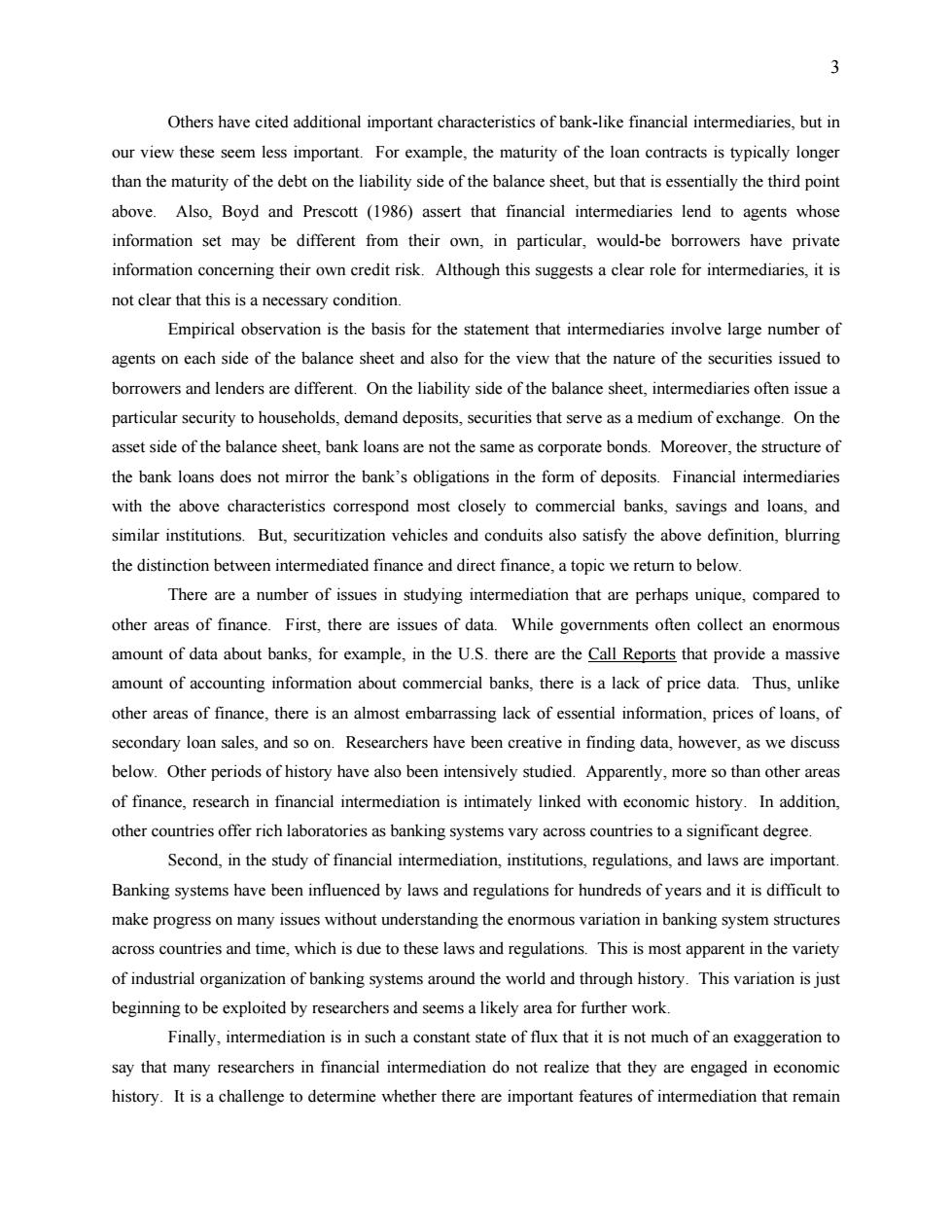
3 Others have cited additional important characteristics of bank-like financial intermediaries,but in our view these seem less important.For example,the maturity of the loan contracts is typically longer than the maturity of the debt on the liability side of the balance sheet,but that is essentially the third point above.Also,Boyd and Prescott (1986)assert that financial intermediaries lend to agents whose information set may be different from their own,in particular,would-be borrowers have private information concerning their own credit risk.Although this suggests a clear role for intermediaries,it is not clear that this is a necessary condition. Empirical observation is the basis for the statement that intermediaries involve large number of agents on each side of the balance sheet and also for the view that the nature of the securities issued to borrowers and lenders are different.On the liability side of the balance sheet,intermediaries often issue a particular security to households,demand deposits,securities that serve as a medium of exchange.On the asset side of the balance sheet,bank loans are not the same as corporate bonds.Moreover,the structure of the bank loans does not mirror the bank's obligations in the form of deposits.Financial intermediaries with the above characteristics correspond most closely to commercial banks,savings and loans,and similar institutions.But,securitization vehicles and conduits also satisfy the above definition,blurring the distinction between intermediated finance and direct finance,a topic we return to below. There are a number of issues in studying intermediation that are perhaps unique,compared to other areas of finance.First,there are issues of data.While governments often collect an enormous amount of data about banks,for example,in the U.S.there are the Call Reports that provide a massive amount of accounting information about commercial banks,there is a lack of price data.Thus,unlike other areas of finance,there is an almost embarrassing lack of essential information,prices of loans,of secondary loan sales,and so on.Researchers have been creative in finding data,however,as we discuss below.Other periods of history have also been intensively studied.Apparently,more so than other areas of finance,research in financial intermediation is intimately linked with economic history.In addition, other countries offer rich laboratories as banking systems vary across countries to a significant degree. Second,in the study of financial intermediation,institutions,regulations,and laws are important. Banking systems have been influenced by laws and regulations for hundreds of years and it is difficult to make progress on many issues without understanding the enormous variation in banking system structures across countries and time,which is due to these laws and regulations.This is most apparent in the variety of industrial organization of banking systems around the world and through history.This variation is just beginning to be exploited by researchers and seems a likely area for further work. Finally,intermediation is in such a constant state of flux that it is not much of an exaggeration to say that many researchers in financial intermediation do not realize that they are engaged in economic history.It is a challenge to determine whether there are important features of intermediation that remain
3 Others have cited additional important characteristics of bank-like financial intermediaries, but in our view these seem less important. For example, the maturity of the loan contracts is typically longer than the maturity of the debt on the liability side of the balance sheet, but that is essentially the third point above. Also, Boyd and Prescott (1986) assert that financial intermediaries lend to agents whose information set may be different from their own, in particular, would-be borrowers have private information concerning their own credit risk. Although this suggests a clear role for intermediaries, it is not clear that this is a necessary condition. Empirical observation is the basis for the statement that intermediaries involve large number of agents on each side of the balance sheet and also for the view that the nature of the securities issued to borrowers and lenders are different. On the liability side of the balance sheet, intermediaries often issue a particular security to households, demand deposits, securities that serve as a medium of exchange. On the asset side of the balance sheet, bank loans are not the same as corporate bonds. Moreover, the structure of the bank loans does not mirror the bank’s obligations in the form of deposits. Financial intermediaries with the above characteristics correspond most closely to commercial banks, savings and loans, and similar institutions. But, securitization vehicles and conduits also satisfy the above definition, blurring the distinction between intermediated finance and direct finance, a topic we return to below. There are a number of issues in studying intermediation that are perhaps unique, compared to other areas of finance. First, there are issues of data. While governments often collect an enormous amount of data about banks, for example, in the U.S. there are the Call Reports that provide a massive amount of accounting information about commercial banks, there is a lack of price data. Thus, unlike other areas of finance, there is an almost embarrassing lack of essential information, prices of loans, of secondary loan sales, and so on. Researchers have been creative in finding data, however, as we discuss below. Other periods of history have also been intensively studied. Apparently, more so than other areas of finance, research in financial intermediation is intimately linked with economic history. In addition, other countries offer rich laboratories as banking systems vary across countries to a significant degree. Second, in the study of financial intermediation, institutions, regulations, and laws are important. Banking systems have been influenced by laws and regulations for hundreds of years and it is difficult to make progress on many issues without understanding the enormous variation in banking system structures across countries and time, which is due to these laws and regulations. This is most apparent in the variety of industrial organization of banking systems around the world and through history. This variation is just beginning to be exploited by researchers and seems a likely area for further work. Finally, intermediation is in such a constant state of flux that it is not much of an exaggeration to say that many researchers in financial intermediation do not realize that they are engaged in economic history. It is a challenge to determine whether there are important features of intermediation that remain
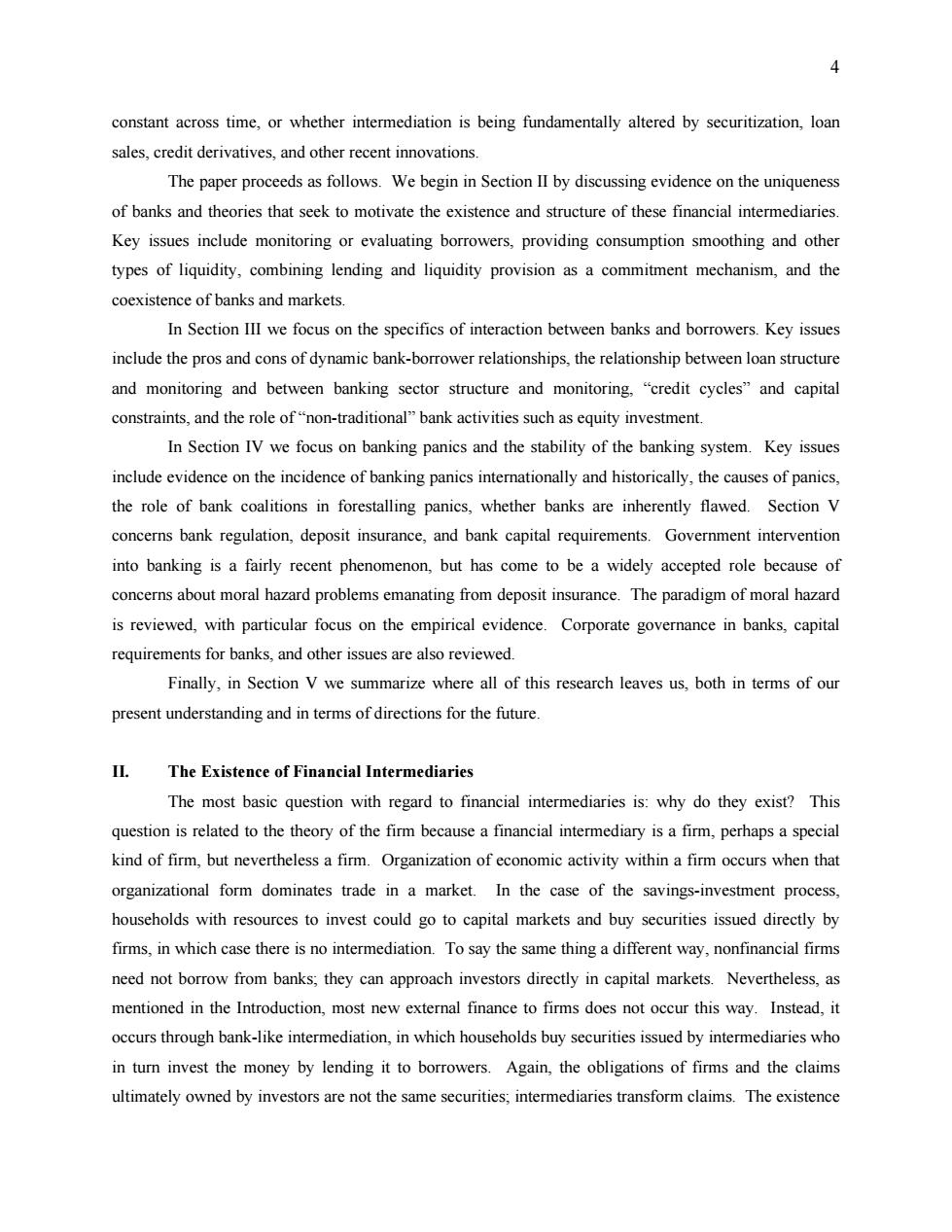
4 constant across time,or whether intermediation is being fundamentally altered by securitization,loan sales,credit derivatives,and other recent innovations. The paper proceeds as follows.We begin in Section II by discussing evidence on the uniqueness of banks and theories that seek to motivate the existence and structure of these financial intermediaries. Key issues include monitoring or evaluating borrowers,providing consumption smoothing and other types of liquidity,combining lending and liquidity provision as a commitment mechanism,and the coexistence of banks and markets. In Section III we focus on the specifics of interaction between banks and borrowers.Key issues include the pros and cons of dynamic bank-borrower relationships,the relationship between loan structure and monitoring and between banking sector structure and monitoring,"credit cycles"and capital constraints,and the role of"non-traditional"bank activities such as equity investment. In Section IV we focus on banking panics and the stability of the banking system.Key issues include evidence on the incidence of banking panics internationally and historically,the causes of panics, the role of bank coalitions in forestalling panics,whether banks are inherently flawed.Section V concerns bank regulation,deposit insurance,and bank capital requirements.Government intervention into banking is a fairly recent phenomenon,but has come to be a widely accepted role because of concerns about moral hazard problems emanating from deposit insurance.The paradigm of moral hazard is reviewed,with particular focus on the empirical evidence.Corporate governance in banks,capital requirements for banks,and other issues are also reviewed. Finally,in Section V we summarize where all of this research leaves us,both in terms of our present understanding and in terms of directions for the future. II. The Existence of Financial Intermediaries The most basic question with regard to financial intermediaries is:why do they exist?This question is related to the theory of the firm because a financial intermediary is a firm,perhaps a special kind of firm,but nevertheless a firm.Organization of economic activity within a firm occurs when that organizational form dominates trade in a market.In the case of the savings-investment process, households with resources to invest could go to capital markets and buy securities issued directly by firms,in which case there is no intermediation.To say the same thing a different way,nonfinancial firms need not borrow from banks;they can approach investors directly in capital markets.Nevertheless,as mentioned in the Introduction,most new external finance to firms does not occur this way.Instead,it occurs through bank-like intermediation,in which households buy securities issued by intermediaries who in turn invest the money by lending it to borrowers.Again,the obligations of firms and the claims ultimately owned by investors are not the same securities;intermediaries transform claims.The existence
4 constant across time, or whether intermediation is being fundamentally altered by securitization, loan sales, credit derivatives, and other recent innovations. The paper proceeds as follows. We begin in Section II by discussing evidence on the uniqueness of banks and theories that seek to motivate the existence and structure of these financial intermediaries. Key issues include monitoring or evaluating borrowers, providing consumption smoothing and other types of liquidity, combining lending and liquidity provision as a commitment mechanism, and the coexistence of banks and markets. In Section III we focus on the specifics of interaction between banks and borrowers. Key issues include the pros and cons of dynamic bank-borrower relationships, the relationship between loan structure and monitoring and between banking sector structure and monitoring, “credit cycles” and capital constraints, and the role of “non-traditional” bank activities such as equity investment. In Section IV we focus on banking panics and the stability of the banking system. Key issues include evidence on the incidence of banking panics internationally and historically, the causes of panics, the role of bank coalitions in forestalling panics, whether banks are inherently flawed. Section V concerns bank regulation, deposit insurance, and bank capital requirements. Government intervention into banking is a fairly recent phenomenon, but has come to be a widely accepted role because of concerns about moral hazard problems emanating from deposit insurance. The paradigm of moral hazard is reviewed, with particular focus on the empirical evidence. Corporate governance in banks, capital requirements for banks, and other issues are also reviewed. Finally, in Section V we summarize where all of this research leaves us, both in terms of our present understanding and in terms of directions for the future. II. The Existence of Financial Intermediaries The most basic question with regard to financial intermediaries is: why do they exist? This question is related to the theory of the firm because a financial intermediary is a firm, perhaps a special kind of firm, but nevertheless a firm. Organization of economic activity within a firm occurs when that organizational form dominates trade in a market. In the case of the savings-investment process, households with resources to invest could go to capital markets and buy securities issued directly by firms, in which case there is no intermediation. To say the same thing a different way, nonfinancial firms need not borrow from banks; they can approach investors directly in capital markets. Nevertheless, as mentioned in the Introduction, most new external finance to firms does not occur this way. Instead, it occurs through bank-like intermediation, in which households buy securities issued by intermediaries who in turn invest the money by lending it to borrowers. Again, the obligations of firms and the claims ultimately owned by investors are not the same securities; intermediaries transform claims. The existence
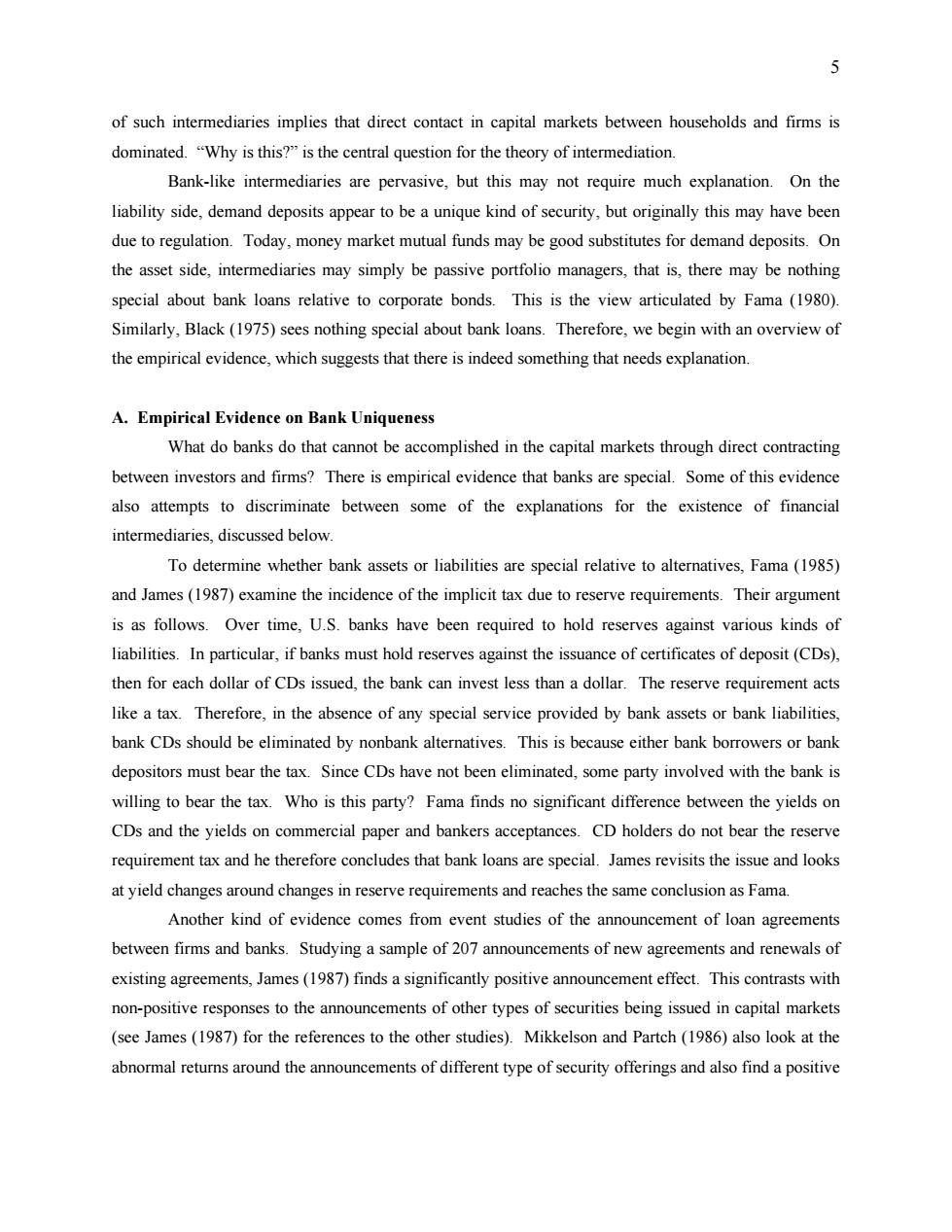
5 of such intermediaries implies that direct contact in capital markets between households and firms is dominated."Why is this?"is the central question for the theory of intermediation. Bank-like intermediaries are pervasive,but this may not require much explanation.On the liability side,demand deposits appear to be a unique kind of security,but originally this may have been due to regulation.Today,money market mutual funds may be good substitutes for demand deposits.On the asset side,intermediaries may simply be passive portfolio managers,that is,there may be nothing special about bank loans relative to corporate bonds.This is the view articulated by Fama (1980). Similarly,Black(1975)sees nothing special about bank loans.Therefore,we begin with an overview of the empirical evidence,which suggests that there is indeed something that needs explanation. A.Empirical Evidence on Bank Uniqueness What do banks do that cannot be accomplished in the capital markets through direct contracting between investors and firms?There is empirical evidence that banks are special.Some of this evidence also attempts to discriminate between some of the explanations for the existence of financial intermediaries,discussed below. To determine whether bank assets or liabilities are special relative to alternatives,Fama(1985) and James (1987)examine the incidence of the implicit tax due to reserve requirements.Their argument is as follows.Over time,U.S.banks have been required to hold reserves against various kinds of liabilities.In particular,if banks must hold reserves against the issuance of certificates of deposit(CDs), then for each dollar of CDs issued,the bank can invest less than a dollar.The reserve requirement acts like a tax.Therefore,in the absence of any special service provided by bank assets or bank liabilities, bank CDs should be eliminated by nonbank alternatives.This is because either bank borrowers or bank depositors must bear the tax.Since CDs have not been eliminated,some party involved with the bank is willing to bear the tax.Who is this party?Fama finds no significant difference between the yields on CDs and the yields on commercial paper and bankers acceptances.CD holders do not bear the reserve requirement tax and he therefore concludes that bank loans are special.James revisits the issue and looks at yield changes around changes in reserve requirements and reaches the same conclusion as Fama. Another kind of evidence comes from event studies of the announcement of loan agreements between firms and banks.Studying a sample of 207 announcements of new agreements and renewals of existing agreements,James(1987)finds a significantly positive announcement effect.This contrasts with non-positive responses to the announcements of other types of securities being issued in capital markets (see James (1987)for the references to the other studies).Mikkelson and Partch (1986)also look at the abnormal returns around the announcements of different type of security offerings and also find a positive
5 of such intermediaries implies that direct contact in capital markets between households and firms is dominated. “Why is this?” is the central question for the theory of intermediation. Bank-like intermediaries are pervasive, but this may not require much explanation. On the liability side, demand deposits appear to be a unique kind of security, but originally this may have been due to regulation. Today, money market mutual funds may be good substitutes for demand deposits. On the asset side, intermediaries may simply be passive portfolio managers, that is, there may be nothing special about bank loans relative to corporate bonds. This is the view articulated by Fama (1980). Similarly, Black (1975) sees nothing special about bank loans. Therefore, we begin with an overview of the empirical evidence, which suggests that there is indeed something that needs explanation. A. Empirical Evidence on Bank Uniqueness What do banks do that cannot be accomplished in the capital markets through direct contracting between investors and firms? There is empirical evidence that banks are special. Some of this evidence also attempts to discriminate between some of the explanations for the existence of financial intermediaries, discussed below. To determine whether bank assets or liabilities are special relative to alternatives, Fama (1985) and James (1987) examine the incidence of the implicit tax due to reserve requirements. Their argument is as follows. Over time, U.S. banks have been required to hold reserves against various kinds of liabilities. In particular, if banks must hold reserves against the issuance of certificates of deposit (CDs), then for each dollar of CDs issued, the bank can invest less than a dollar. The reserve requirement acts like a tax. Therefore, in the absence of any special service provided by bank assets or bank liabilities, bank CDs should be eliminated by nonbank alternatives. This is because either bank borrowers or bank depositors must bear the tax. Since CDs have not been eliminated, some party involved with the bank is willing to bear the tax. Who is this party? Fama finds no significant difference between the yields on CDs and the yields on commercial paper and bankers acceptances. CD holders do not bear the reserve requirement tax and he therefore concludes that bank loans are special. James revisits the issue and looks at yield changes around changes in reserve requirements and reaches the same conclusion as Fama. Another kind of evidence comes from event studies of the announcement of loan agreements between firms and banks. Studying a sample of 207 announcements of new agreements and renewals of existing agreements, James (1987) finds a significantly positive announcement effect. This contrasts with non-positive responses to the announcements of other types of securities being issued in capital markets (see James (1987) for the references to the other studies). Mikkelson and Partch (1986) also look at the abnormal returns around the announcements of different type of security offerings and also find a positive
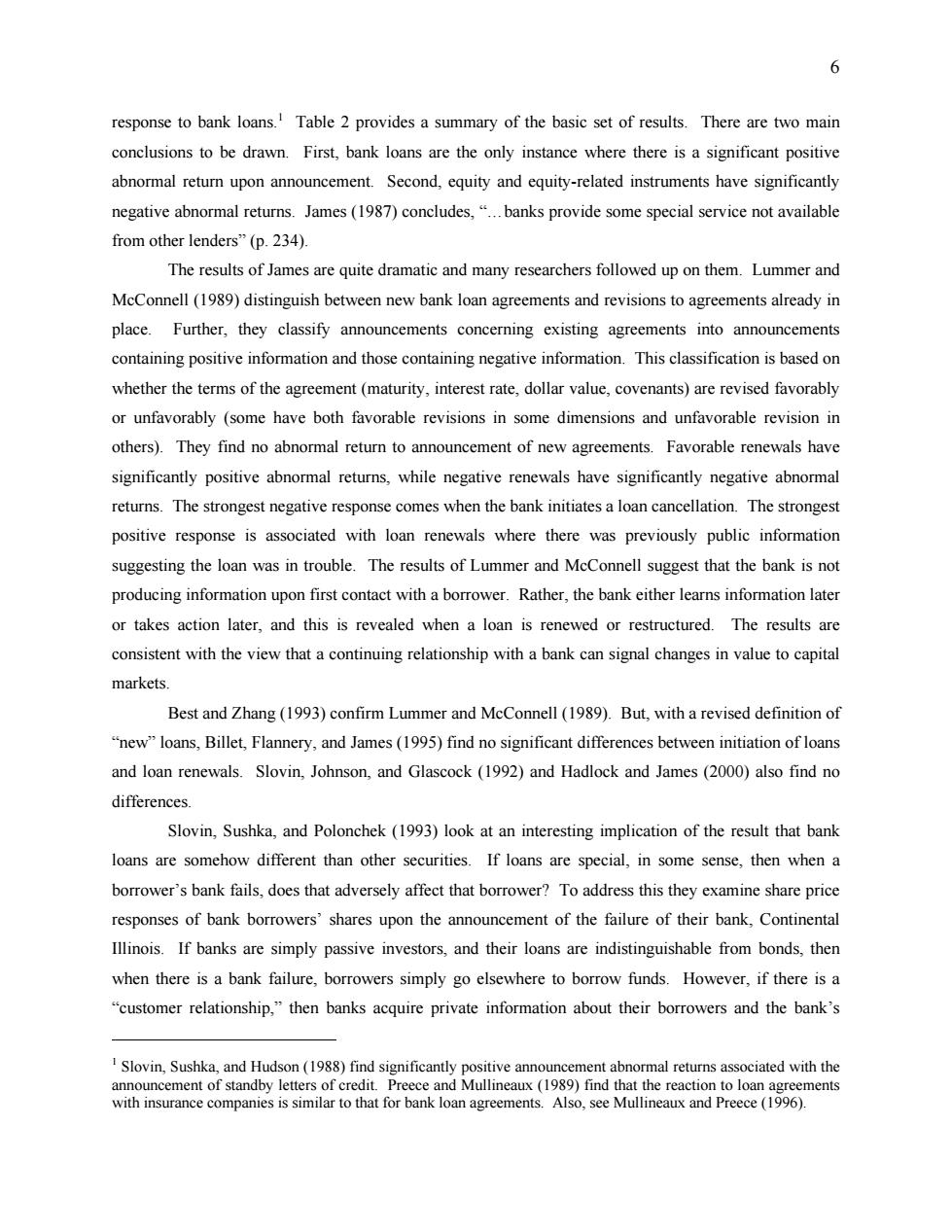
6 response to bank loans.Table 2 provides a summary of the basic set of results.There are two main conclusions to be drawn.First,bank loans are the only instance where there is a significant positive abnormal return upon announcement.Second,equity and equity-related instruments have significantly negative abnormal returns.James(1987)concludes,"banks provide some special service not available from other lenders"(p.234). The results of James are quite dramatic and many researchers followed up on them.Lummer and McConnell(1989)distinguish between new bank loan agreements and revisions to agreements already in place.Further,they classify announcements concerning existing agreements into announcements containing positive information and those containing negative information.This classification is based on whether the terms of the agreement(maturity,interest rate,dollar value,covenants)are revised favorably or unfavorably (some have both favorable revisions in some dimensions and unfavorable revision in others).They find no abnormal return to announcement of new agreements.Favorable renewals have significantly positive abnormal returns,while negative renewals have significantly negative abnormal returns.The strongest negative response comes when the bank initiates a loan cancellation.The strongest positive response is associated with loan renewals where there was previously public information suggesting the loan was in trouble.The results of Lummer and McConnell suggest that the bank is not producing information upon first contact with a borrower.Rather,the bank either learns information later or takes action later,and this is revealed when a loan is renewed or restructured.The results are consistent with the view that a continuing relationship with a bank can signal changes in value to capital markets. Best and Zhang(1993)confirm Lummer and McConnell (1989).But,with a revised definition of "new"loans,Billet,Flannery,and James(1995)find no significant differences between initiation of loans and loan renewals.Slovin,Johnson,and Glascock (1992)and Hadlock and James (2000)also find no differences. Slovin,Sushka,and Polonchek(1993)look at an interesting implication of the result that bank loans are somehow different than other securities.If loans are special,in some sense,then when a borrower's bank fails,does that adversely affect that borrower?To address this they examine share price responses of bank borrowers'shares upon the announcement of the failure of their bank,Continental Illinois.If banks are simply passive investors,and their loans are indistinguishable from bonds,then when there is a bank failure,borrowers simply go elsewhere to borrow funds.However,if there is a "customer relationship,"then banks acquire private information about their borrowers and the bank's I Slovin,Sushka,and Hudson(1988)find significantly positive announcement abnormal returns associated with the announcement of standby letters of credit.Preece and Mullineaux(1989)find that the reaction to loan agreements with insurance companies is similar to that for bank loan agreements.Also,see Mullineaux and Preece(1996)
6 response to bank loans.1 Table 2 provides a summary of the basic set of results. There are two main conclusions to be drawn. First, bank loans are the only instance where there is a significant positive abnormal return upon announcement. Second, equity and equity-related instruments have significantly negative abnormal returns. James (1987) concludes, “…banks provide some special service not available from other lenders” (p. 234). The results of James are quite dramatic and many researchers followed up on them. Lummer and McConnell (1989) distinguish between new bank loan agreements and revisions to agreements already in place. Further, they classify announcements concerning existing agreements into announcements containing positive information and those containing negative information. This classification is based on whether the terms of the agreement (maturity, interest rate, dollar value, covenants) are revised favorably or unfavorably (some have both favorable revisions in some dimensions and unfavorable revision in others). They find no abnormal return to announcement of new agreements. Favorable renewals have significantly positive abnormal returns, while negative renewals have significantly negative abnormal returns. The strongest negative response comes when the bank initiates a loan cancellation. The strongest positive response is associated with loan renewals where there was previously public information suggesting the loan was in trouble. The results of Lummer and McConnell suggest that the bank is not producing information upon first contact with a borrower. Rather, the bank either learns information later or takes action later, and this is revealed when a loan is renewed or restructured. The results are consistent with the view that a continuing relationship with a bank can signal changes in value to capital markets. Best and Zhang (1993) confirm Lummer and McConnell (1989). But, with a revised definition of “new” loans, Billet, Flannery, and James (1995) find no significant differences between initiation of loans and loan renewals. Slovin, Johnson, and Glascock (1992) and Hadlock and James (2000) also find no differences. Slovin, Sushka, and Polonchek (1993) look at an interesting implication of the result that bank loans are somehow different than other securities. If loans are special, in some sense, then when a borrower’s bank fails, does that adversely affect that borrower? To address this they examine share price responses of bank borrowers’ shares upon the announcement of the failure of their bank, Continental Illinois. If banks are simply passive investors, and their loans are indistinguishable from bonds, then when there is a bank failure, borrowers simply go elsewhere to borrow funds. However, if there is a “customer relationship,” then banks acquire private information about their borrowers and the bank’s 1 Slovin, Sushka, and Hudson (1988) find significantly positive announcement abnormal returns associated with the announcement of standby letters of credit. Preece and Mullineaux (1989) find that the reaction to loan agreements with insurance companies is similar to that for bank loan agreements. Also, see Mullineaux and Preece (1996)
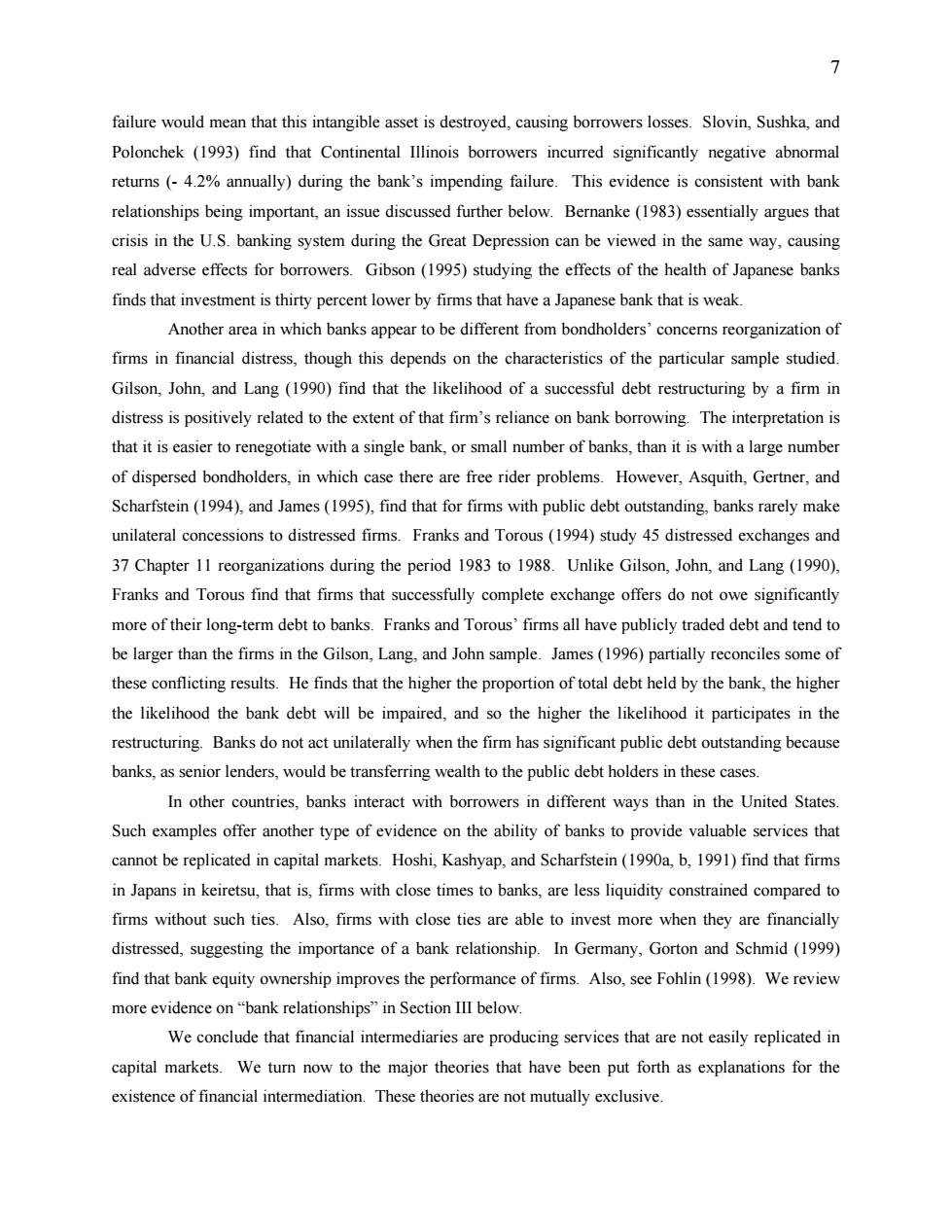
7 failure would mean that this intangible asset is destroyed,causing borrowers losses.Slovin,Sushka,and Polonchek (1993)find that Continental Illinois borrowers incurred significantly negative abnormal returns(-4.2%annually)during the bank's impending failure.This evidence is consistent with bank relationships being important,an issue discussed further below.Bernanke (1983)essentially argues that crisis in the U.S.banking system during the Great Depression can be viewed in the same way,causing real adverse effects for borrowers.Gibson(1995)studying the effects of the health of Japanese banks finds that investment is thirty percent lower by firms that have a Japanese bank that is weak. Another area in which banks appear to be different from bondholders'concerns reorganization of firms in financial distress,though this depends on the characteristics of the particular sample studied. Gilson,John,and Lang (1990)find that the likelihood of a successful debt restructuring by a firm in distress is positively related to the extent of that firm's reliance on bank borrowing.The interpretation is that it is easier to renegotiate with a single bank,or small number of banks,than it is with a large number of dispersed bondholders,in which case there are free rider problems.However,Asquith,Gertner,and Scharfstein(1994),and James(1995),find that for firms with public debt outstanding,banks rarely make unilateral concessions to distressed firms.Franks and Torous(1994)study 45 distressed exchanges and 37 Chapter 11 reorganizations during the period 1983 to 1988.Unlike Gilson,John,and Lang (1990), Franks and Torous find that firms that successfully complete exchange offers do not owe significantly more of their long-term debt to banks.Franks and Torous'firms all have publicly traded debt and tend to be larger than the firms in the Gilson,Lang,and John sample.James(1996)partially reconciles some of these conflicting results.He finds that the higher the proportion of total debt held by the bank,the higher the likelihood the bank debt will be impaired,and so the higher the likelihood it participates in the restructuring.Banks do not act unilaterally when the firm has significant public debt outstanding because banks,as senior lenders,would be transferring wealth to the public debt holders in these cases. In other countries,banks interact with borrowers in different ways than in the United States. Such examples offer another type of evidence on the ability of banks to provide valuable services that cannot be replicated in capital markets.Hoshi,Kashyap,and Scharfstein(1990a,b,1991)find that firms in Japans in keiretsu,that is,firms with close times to banks,are less liquidity constrained compared to firms without such ties.Also,firms with close ties are able to invest more when they are financially distressed,suggesting the importance of a bank relationship.In Germany,Gorton and Schmid (1999) find that bank equity ownership improves the performance of firms.Also,see Fohlin(1998).We review more evidence on "bank relationships"in Section III below. We conclude that financial intermediaries are producing services that are not easily replicated in capital markets.We turn now to the major theories that have been put forth as explanations for the existence of financial intermediation.These theories are not mutually exclusive
7 failure would mean that this intangible asset is destroyed, causing borrowers losses. Slovin, Sushka, and Polonchek (1993) find that Continental Illinois borrowers incurred significantly negative abnormal returns (- 4.2% annually) during the bank’s impending failure. This evidence is consistent with bank relationships being important, an issue discussed further below. Bernanke (1983) essentially argues that crisis in the U.S. banking system during the Great Depression can be viewed in the same way, causing real adverse effects for borrowers. Gibson (1995) studying the effects of the health of Japanese banks finds that investment is thirty percent lower by firms that have a Japanese bank that is weak. Another area in which banks appear to be different from bondholders’ concerns reorganization of firms in financial distress, though this depends on the characteristics of the particular sample studied. Gilson, John, and Lang (1990) find that the likelihood of a successful debt restructuring by a firm in distress is positively related to the extent of that firm’s reliance on bank borrowing. The interpretation is that it is easier to renegotiate with a single bank, or small number of banks, than it is with a large number of dispersed bondholders, in which case there are free rider problems. However, Asquith, Gertner, and Scharfstein (1994), and James (1995), find that for firms with public debt outstanding, banks rarely make unilateral concessions to distressed firms. Franks and Torous (1994) study 45 distressed exchanges and 37 Chapter 11 reorganizations during the period 1983 to 1988. Unlike Gilson, John, and Lang (1990), Franks and Torous find that firms that successfully complete exchange offers do not owe significantly more of their long-term debt to banks. Franks and Torous’ firms all have publicly traded debt and tend to be larger than the firms in the Gilson, Lang, and John sample. James (1996) partially reconciles some of these conflicting results. He finds that the higher the proportion of total debt held by the bank, the higher the likelihood the bank debt will be impaired, and so the higher the likelihood it participates in the restructuring. Banks do not act unilaterally when the firm has significant public debt outstanding because banks, as senior lenders, would be transferring wealth to the public debt holders in these cases. In other countries, banks interact with borrowers in different ways than in the United States. Such examples offer another type of evidence on the ability of banks to provide valuable services that cannot be replicated in capital markets. Hoshi, Kashyap, and Scharfstein (1990a, b, 1991) find that firms in Japans in keiretsu, that is, firms with close times to banks, are less liquidity constrained compared to firms without such ties. Also, firms with close ties are able to invest more when they are financially distressed, suggesting the importance of a bank relationship. In Germany, Gorton and Schmid (1999) find that bank equity ownership improves the performance of firms. Also, see Fohlin (1998). We review more evidence on “bank relationships” in Section III below. We conclude that financial intermediaries are producing services that are not easily replicated in capital markets. We turn now to the major theories that have been put forth as explanations for the existence of financial intermediation. These theories are not mutually exclusive